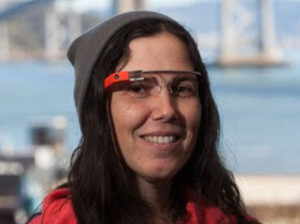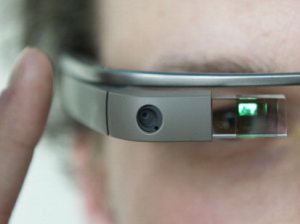redo Jump to...
print Print...

Cecilia Abadie was pulled over on October 29th and given a ticket for wearing the smart device while driving.
(by Heather Kelly, CNN) – In what might be a first, a woman in California received a traffic ticket for wearing Google Glass while driving.
Cecilia Abadie was pulled over for speeding on Tuesday in San Diego and given an additional citation for driving while wearing her Google Glass. The officer considered the head-mounted display a monitor that was visible to the driver. Shocked, Abadie posted a copy of the ticket on Google+.
Traffic laws vary state by state, but many now have broad distracted-driving laws or bans on certain monitors that could easily apply to Google Glass.
The California law cited in Abadie’s case is meant to prevent people from watching television while driving. V C 27602 prohibits televisions and similar monitors from being turned on and facing the driver. There are exceptions for GPS and mapping tools and screens that display camera feeds to help the driver navigate. If a device has a safety feature that limits its display to approved uses while driving, it can be allowed.
“I think the law is broad enough to say it violates the law,” said San Diego attorney Mitchell Mehdy, also known as “Mr. Ticket.” Mehdy has been working in traffic law for 25 years and said this is the first case he’s heard of involving Google Glass.
Abadie says her Google Glass was not turned on when she was pulled over, and that the officer said the screen was blocking her view. The Google Glass display is located slightly above the right eye, not directly in front of the eye.
Google does warn users about running afoul of traffic laws in its Google Glass FAQ: “Most states have passed laws limiting the use of mobile devices while driving any motor vehicle, and most states post those rules on their department of motor vehicles websites. Read up and follow the law!”
However, in another section on navigation, it says Glass can give turn-by-turn directions, “whether you’re on a bike, in a car, taking the subway, or going by foot.”
 Glass fans defended the technology in comments on Abadie’s post, saying that a voice-activated screen close to the eye could actually be safer than trying to check a smartphone or other monitor while driving.
Glass fans defended the technology in comments on Abadie’s post, saying that a voice-activated screen close to the eye could actually be safer than trying to check a smartphone or other monitor while driving.
“Glass is far safer than any other means of information delivery. It is out of your view and not distracting,” said Aaron Kasten, who compared it to checking speed and other information on a car’s dashboard, which requires taking your eyes off of the road.
The turn-by-turn directions on Glass can be turned on with a voice command. The display will show a map view, but for extra safety the screen can be turned off while driving so there’s only voice navigation.
A Google Glass spokesperson didn’t address the ticket directly but emphasized responsible Google Glass usage, saying, “As we make clear in our help center, Explorers should always use Glass responsibly and put their safety and the safety of others first. More broadly, Glass is built to connect you more with the world around you, not distract you from it.”
Abadie could take the case to court and try to get the Google Glass portion of the ticket dismissed.
“How can this officer prove that this display was being activated or was actually on at the time and what kind of signal she’s getting?” said Mehdy.
State laws are always adapting to new technology, and Google Glass is still a somewhat rare sighting. The device is only available as part of a beta program and is not yet sold commercially. According to Mehdy, new technology is a tempting target for law enforcement looking for new ways to bring in money.
“There’s a wealth of revenue to be generated from technology. The traffic law enforcement is coming and saying wow, we’ve got this new incredible device and we want our piece too,” said Mehdy. With a mandatory minimum fine in California is $162, this is just the beginning of more tickets for Google Glass wearers according to Mehdy.
Law enforcement is increasingly enforcing distracted driving laws. During the month of April, there were more that 57,000 distracted driving tickets issued in California as part of Distracted Driving Awareness Month, according to the California Office of Traffic Safety.
Reprinted here for educational purposes only. May not be reproduced on other websites without permission from CNN.
Questions
1. Why did a California policeman give a woman a traffic ticket for wearing Google Glass while driving?
2. What was the original purpose for California law V C 27602?
3. For what reason did the officer initially stop Ms. Abadie?
4. a) Ms. Abadie says she plans to fight the ticket. How does she defend her position?
b) What does the reporter note about the position of Google Glass on a wearer’s face?
5. How did one Google Glass fan defend its use while driving?
6. San Diego attorney Mitchell Mehdy has been working in traffic law for 25 years. He said: “There’s a wealth of revenue to be generated from technology. The traffic law enforcement is coming and saying wow, we’ve got this new incredible device and we want our piece too.” With a mandatory minimum fine in California is $162, this is just the beginning of more tickets for Google Glass wearers, according to Mehdy. CNN reports: “Law enforcement is increasingly enforcing distracted driving laws. During the month of April, there were more that 57,000 distracted driving tickets issued in California as part of Distracted Driving Awareness Month, according to the California Office of Traffic Safety.”
a) How can Google Glass users avoid getting tickets under California law V C 27602?
b) Are distracted driving laws necessary? Explain your answer.
Background
The text of California law V C Section 27602 Television:
A person shall not drive a motor vehicle if a television receiver, a video monitor, or a television or video screen, or any other similar means of visually displaying a television broadcast or video signal that produces entertainment or business applications, is operating and is located in the motor vehicle at a point forward of the back of the driver’s seat, or is operating and the monitor, screen, or display is visible to the driver while driving the motor vehicle. (from dmv.ca.gov)
Daily “Answers” emails are provided for Daily News Articles, Tuesday’s World Events and Friday’s News Quiz.



